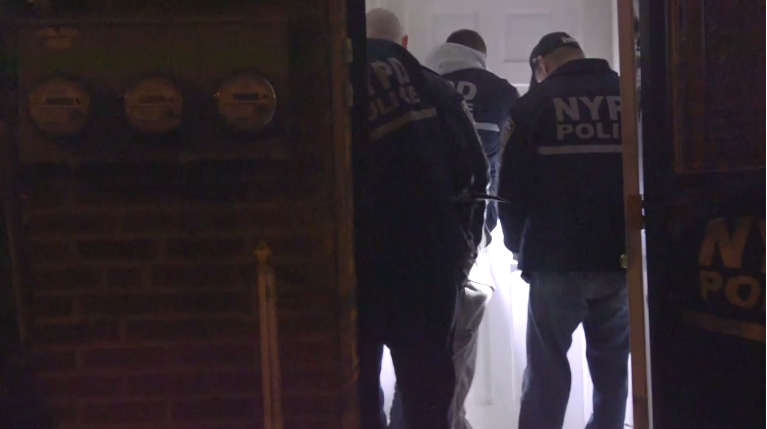
NYPDNews.com
A scene from an NYPD video about the April 26-27 raids.
When police and the Manhattan District Attorney’s office launched a massive raid in West Harlem in 2014, only a handful of voices diverged from the official narrative of gangs, or “crews,” terrorizing the community. Some of those voices were of family members of those arrested, who railed against a raid they said ensnared too many innocent young men. Residents of the Grant and Manhattanville Houses assailed law enforcement officials for casting too wide of a net in their takedown. Not enough was done, they also pointed out, to steer young people away from violence in the first place.
Instead the city secretly built cases on young people. The police department’s Operation Crew Cut, described as a “virtual Stop and Frisk”, and Operation Ceasefire have put a focus on crews, less formal groupings of young men that are often compared to gangs. This focus on crews by a policing regime that used to target only real gangs has only happened in the last 10 years. Ironically, the shift may have been prompted by the declining crime rate. In a city with historical lows in shootings and murders, there is a premium on the last frontiers of violence. Still, getting public support for widening the net requires hyping up the crews’ menace to “New Jack City” levels.
Early last Wednesday morning, the NYPD, in collaboration with multiple federal agencies, arrested over 120 suspected crew members in the Bronx, mostly in the Eastchester Gardens Houses, topping 2014’s raid for the largest sweep the city has ever seen. The week prior, cops and FBI agents outfitted in full tactical military gear with support from helicopters equipped with infrared video imaging, launched a raid in the Washington and East River Houses where Officer Randolph Holder’s reported killer had been living.
Since Holder’s death last year in Spanish Harlem, raids have become more frequent across the city. Now Police Commissioner Bill Bratton is vowing more.
Pre-dawn raids, however, won’t solve the issue of violence in public housing. While no one can deny that violence persists in some public housing developments, making the streets of Harlem and the Bronx look like Fallujah sends a chilling message to thousands of low-income public housing residents: We’re at war with you. Most residents I spoke with at Eastchester Gardens that night felt that the raid was over the top. The neighborhood, some said, was relatively safe.
That didn’t stop a circus of news trucks and reporters from flocking to the Bronx on Wednesday to report on mindless gang violence. A handful of murders were spun in such a way that the Bronx neighborhood would seem to be plagued by wanton bloodshed. In fact, the media narrative had been already begun to take shape a few months ago. The Daily News laid the initial foundation for an avalanche of raids by publishing a multi-part exposé on the “Gangs of New York” back in January. It included an  [/caption]
[/caption]
For some adolescents living in poverty in the city, joining a crew can often be a survival tactic. For those that don’t, you can still be associated with a local crew, which are usually territorial, by simply living in development where one might be based. Police and prosecutors enjoy unchecked discretion in determining who they say gangbangers are. And police don’t only surveill social media posts and music videos, they participate by creating fake accounts to probe and egg on what are oftentimes impetuous teenagers. Throw in the constant contact cops use to keep tabs on suspected offenders, sometime by busting them for small offenses, and you have police overzealously mining alleged crew members for information that is at best questionable.
Another issue is the free-wheeling way that prosecutors, armed with questionable intel, use conspiracy laws to go after suspected offenders. Manhattan District Attorney Cyrus Vance has used conspiracy laws, birthed by 1970’s era RICO laws to take down the mafia, to go after these so-called crews. In short, conspiracy says that you need only be a member of a group that’s accused of a crime to be implicated. Most of those indicted, not able to afford the attorneys that a John Gotti might, are overwhelmed by the long sentences conspiracy charges bring and simply cop a plea.
While it may be next to impossible to defend those who’ve characterized as murderous gang bangers in the press and by police, the pressing question is what could have been done instead of a raid. Violence in NYCHA is inextricably linked to poverty and lack of resources. Even Bharara had to acknowledge the deplorable conditions of the city’s public housing. From elevators that don’t work to urine-soaked and dimly lit staircases—like the one that Akai Gurley was killed in—the city and federal government have long turned their backs on the poor.
Of the city’s $210 million investment into public housing safety in 2014, over $70 million went to security cameras and extra cops. Only $15 million went to social programming.
Young public housing residents need help. They need to be showered with opportunities and programming. In West Harlem, the expansion of Columbia University into the neighborhood was supposed to include benefits for the community, but has largely failed to reach those on the ground. Raids shouldn’t be allowed to become the new normal. Not only are these young men essentially being denied their presumption of innocence, we’re throwing substantial chunks of a poor generation behind bars, where gang life thrives.
Raids do nothing to help a community in the long run. They instead simply cut off a public housing development’s nose to spite its face.









4 thoughts on “No Backspace: NYPD Raids Won’t Solve NYCHA’s Violence Problem”
come on city limits YOU KNOW THE ANSWER………………..PUT METAL DETECTORS FULL BODY SCANNERS AT ALL PUBLIC HOUSING PROJECTS……we pay their rent so why not demand safety in exchange…
then allow 1 or 2 days a month when you can avoid the detectors and move out, but you lose all public assistance benefits and you go back to the end of the line for section 8 housing. FAIR IS FAIR!
Pingback: ‘Using Media to Create This Idea There’s a Gang on Every Street Corner’ | FAIR
Pingback: 'Using Media to Create This Idea There's a Gang on Every Street Corner' | Radio Free
Good down to earth writeup.. I live in Los Angeles with a long ago association as a gang member. In casual conversation with my nephew, then a policemen (LAPD) assigned to, “Crash, a police-unit specializing in gang infiltration and arrests, jokingly with the ease of thought said. “say man tell them (excuse the foul word) niggas start killing each other I need the overtime”, shit uncle, the overtime alone paid for (no-name) your nephew’s first two years of college”…
This got me to thinking, its been over thirty-eight years sense the ace-duce-hat days of my gang activity. Within that time, I got married; had three children and raised a nephew sense birth; became wealthy as a real estate investor; afforded college tuition for two sons to attend the University of Southern California (USC); got a pilot license and scuba dive in just about every corner of the world… And here I am being asked to help create violence (killings at that) so my policeman nephew could make some more overtime… Its all about the dollar. The community is merely lambs-meat (inability to defend themselves) as law enforcement, attorney’s, prosecutors, jailers, prison builders, and politicians are the meat-eaters…
No matter what’s said, they are all knowingly aware, this thumb pressing of the have-nots is the right of passage and least costly avenue to gain attention and wealth.. No different than the military having a vested interest in war. Without war, smaller budget…
The comedian Richard Pryor was correct in saying, “its not justice, its just-us”…